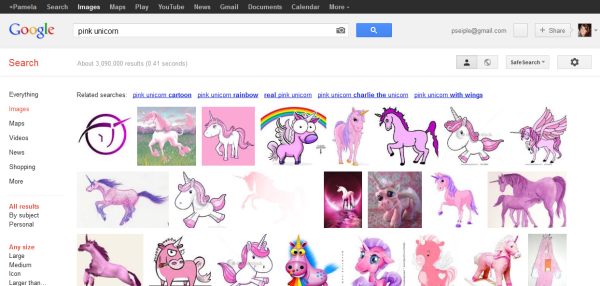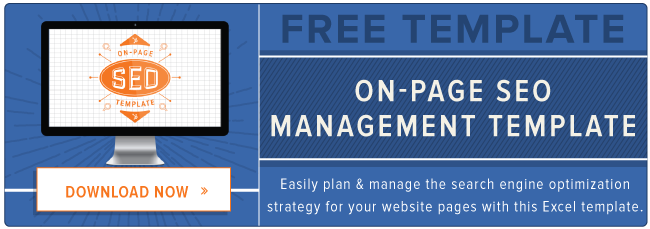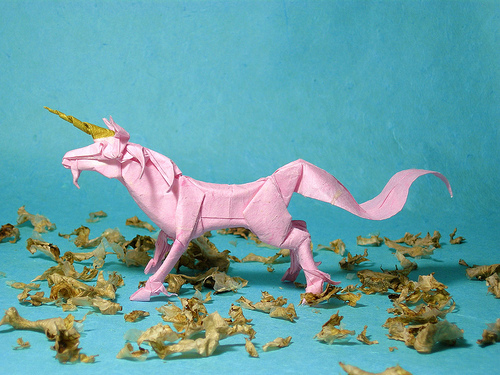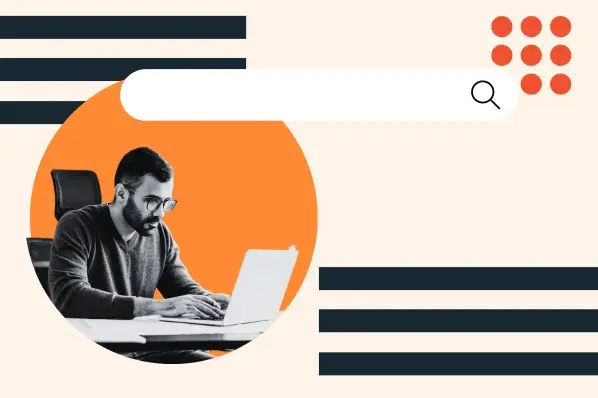There's no doubt about it: the visual content revolution is upon us, as is evident by the infographic craze, the popularity of websites like Pinterest, and the success of visual content on social media sites like Facebook and Google+.
It's no surprise then that today on the Official Google Webmaster blog, Google shared some helpful tips on how to effectively optimize your website's visual content and images to get found in Google's Image Search. We thought these tips, in addition to the Image Publishing Guidelines Google encourages, were definitely worthy of sharing with you, especially if you're experimenting with ways to make your marketing content more visual so you can take advantage of the increased popularity of visual content.
Do you know how to properly optimize that fabulous pink paper unicorn image seen at top right? You will after you read this simple tutorial!
How Google Identifies and Indexes Images
So what exactly does Google look at when indexing images? Let's check out a quick overview before we explain how to optimize your images.
First, it checks out image type. The image types Google can index include BMP, GIF, JPEG, PNG, WebP, and SVG. To learn more about a particular image when Google's algorithms index an image, Google looks at the written copy on the page where the image was found as well as the page's title and body. Google also considers anchor text pointing to the image, the image’s filename, and its alt text. In addition, Google may use other methods like computer vision (methods for acquiring, processing, analyzing, and understanding images) and the caption from the Image Sitemap (a Sitemap incorporating image-specific tags, which we'll elaborate on later in this post), if available, to learn more about the images it finds.

How to Optimize Images So Google Can Index Them in Search
In order to make it easier for Google to find and index your images, Google suggests the following:
1) Only Use Google-Supported Image Formats on Your Site
As we already mentioned, the image types Google can index include BMP, GIF, JPEG, PNG, WebP, and SVG, so be sure to only use these image file types on your website to make it possible for Google to index them.
2) Name the Filenames of Your Images Using Descriptive Words Related to the Content of the Image
In other words, name your image files something that is indicative of what the image is itself, rather than something like IMG2394870.jpg. For instance, if you're a paper vendor, and you uploaded that image at the top of this post of a pink paper unicorn made using your paper, you might name it pink-paper-unicorn.jpg. Descriptive filenames are also helpful for users who come across your images in search, since Google admits to using filenames as the image's snippet in search results when it can't locate any relevant text on the page that references the image.
3) Use Image Alt Text to Describe Images
Because Google and other search engines have a difficult time "seeing" images, use the alt text to describe it in a way that humans would read and understand, similar to how you'd choose a filename. In the alt text for that same pink paper unicorn image, for example, you might describe it as pink paper unicorn.
The alt text of an image is very important for a couple of reasons. First, because it lets Google know what the subject matter of the image is. Google then uses this information to determine the best images to return for a searcher's query. Second, because it provides users who are unable to see images on web pages -- whether they have visual impairments or are using devices with low-bandwidth connections -- to be able to interpret images. For these reasons, Google recommends you be as descriptive as possible, citing the following examples of bad, better, and best alt text for an image:
Bad: alt=""
Better: alt="puppy"
Best: alt="Dalmatian puppy playing fetch"
Avoid: alt="puppy dog baby dog pup pups puppies doggies pups litter puppies dog retriever labrador wolfhound setter pointer puppy jack russell terrier puppies dog food cheap dog food puppy food"
As you can see, Google also advises against using an alt text naming approach similar to ' keyword stuffing.'
4) Provide Context for the Image in the Page's Surrounding Text
It helps Google if the text on the page where the image is located mentions the image, too, so always try to reference your images in your text, close to where it lives on the page, using keywords similar to the alt text/filename of the image. Continuing with our pink paper unicorn example, let's say you had inserted that image into a blog post about creative uses of your paper. To ensure that Google better understood what that image was about, you'd reference it in the text of your blog post near where the image was placed (notice how we also did this at the top of this very post?). For example, you might write:
"To the right, check out the exquisite example of the pink paper unicorn one of our customers made using our handmade paper product."
Google also recommends providing descriptive titles and captions for your images, so consider adding those when relevant.
5) Submit an Image Sitemap
Google encourages website owners to submit what's called an Image Sitemap, which helps the Google team learn about your website's new images as well as determine what those images are about. You may already be familiar with Sitemaps in general, which offer a way to tell Google about the pages on your website it might not otherwise discover. In the simplest sense, a Sitemap is a list of the pages on your website.
Similarly, you can also use Google's image extensions for Sitemaps to give Google additional information about the images on your website. This helps Google discover images it might not have otherwise discovered. In addition, it enables you to identify the most important images on your own website. To create an Image Sitemap, you'll have to add image-specific tags to a Sitemap, or just update an existing Sitemap. To learn more about how to create and submit an Image Sitemap to Google, visit this page.
6) File Size? Forgettaboutit!
Don't worry about the size of the images you embed on your website, at least when it comes to their ability to get indexed in Google search. Google clarifies that it doesn't discriminate, and will index images of all sizes -- no restrictions.
7) Avoid Embedding Text Within Images
While image size may not be a factor, Google does offer a word of warning against including important text in images -- particularly for elements like page headings and menu items -- with the reason being that not all users can access these images, and they'd be missing out on important information. Always save important text-based messages for the regular text-based HTML. Think of it this way: if a user would be confused or missing out on important information if the image wasn't viewable, you should save the text in the image for regular text-based HTML.
8) Use Descriptive Anchor Text When Linking to Images
Although you essentially have no control over the anchor text external pages use when linking to your images, you do have control over the anchor text you use in the links on your own site. Make sure this anchor text is useful, relevant, and descriptive of your images to clearly indicate to users the destination of your links. This will also make for a better user experience. For example, if you were linking to an album of origami paper animal creations made using your handmade paper, you might make the anchor text, Origami Animals Made With Handmade Paper.
9) Protect Your Images
Images on the web are easily sharable, and what this often results in is multiple copies of the image floating around the web, many of which are lacking appropriate attribution. Just think about some of the controversy surrounding Pinterest and users' improper use and attribution of images, for example.
In fact, what happens a lot is the original source getting buried in the rankings by copies if the copies version is better optimized using the tips above. So "if the original source is a page from an image gallery that has very little text," remarks Google, "it can happen that a page with more textual context is chosen to be shown in search." While Google tries to use as many signals as it can find to identify the original source of the image, they encourage users to provide as much attribution information as possible when using sourced images.
If you're concerned about others abusing, misusing, or not crediting the original images you embed on your website, make your images available under an attribution license that require users to attribute you as the source and link back to your website. You can use such licensing services as Creative Commons to easily implement this.
10) Consider User Experience
As is evident by the huge popularity of visual websites like Pinterest, using images and visuals is a great way to boost site traffic. But Google also encourages users not to overlook the user experience of those site visitors. Thus, Google recommends the following best practices for creating a positive user experience through use of images:
- Use High-Quality Images: Not only are they more professional-looking and sharper-looking in the thumbnail versions displayed in Google Image Search, but they are also more effective at attracting inbound links and generating traffic when shared on third-party websites like Pinterest.
- Create Standalone Pages for Important Images: You may use images on various pages of your site, but if you want a certain image to rank well in search, consider creating a dedicated page for that image where you can aggregate all its related information in one place. We recommend doing this for original images such as infographics, visualizations, and other original images your business creates.
- Place Images Above the Fold: In other words, don't make visitors scroll down on the page to view your image. This will help you to immediately capture the attention of your visitors.
- Create Directories to Curate Similar Images: This is particularly important if you have a visual business such as a photographer or an artist. Make it easy for your users to browse through relative images.
- Optimize Images to Load Quickly: This will prevent the text on your page from loading before the images do. Check out Google's Optimizing Web Graphics guide for more info.
Are you taking measures to ensure that your visual content is easily findable in search?
Image Credit: EmreAyar

On-page SEO





![The Fundamentals of On-Page SEO [+How-To Checklists and Templates]](https://53.fs1.hubspotusercontent-na1.net/hubfs/53/on-page-seo-1.png)




.jpg)
